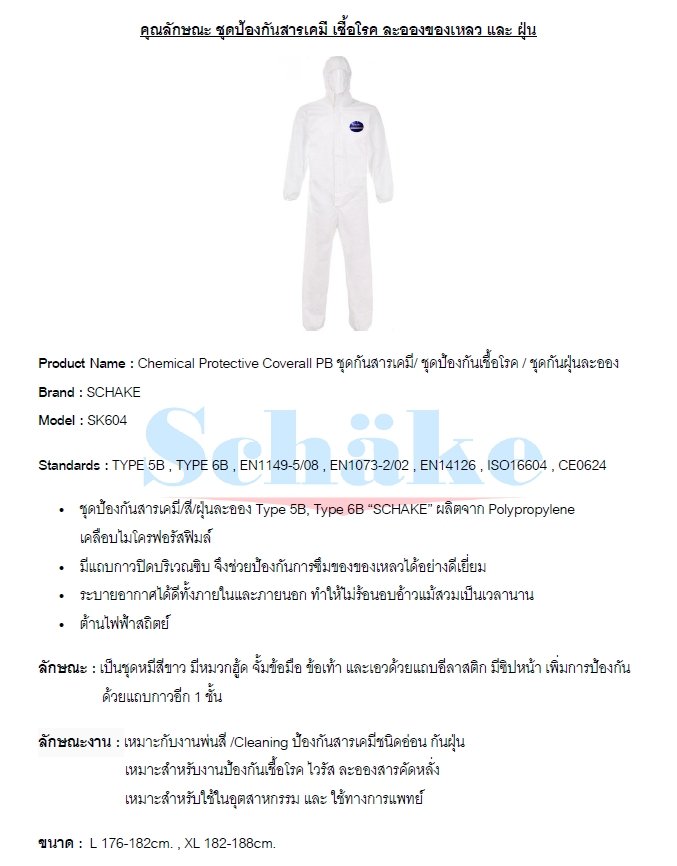What is the EN 14126 standard in PPE?
5886 Views |

1. What is the EN 14126 standard test? The EN 14126 standard is specifically used for testing fabrics only and is not a test or certification for the entire PPE garment.
The testing of PPE garments will be conducted according to standards that define the type, or EN "Type," as follows:
EN 13034 (used for testing Type 6 garments by assessing protection against aerosol sprays).
EN 13982 (used for testing Type 5 garments by assessing protection against harmful dust particles).
EN 14605 (used for testing Type 3 and 4 garments by assessing protection against pressurized sprays and water-based mist, such as jet and shower-type sprays).
EN 943 (used for testing Type 1 garments for protection against gases and vapors).
If the PPE garment passes a specific type of test, it will be labeled with that type, such as "Type 5" or "Type 6." Additionally, if the fabric has been tested according to EN 14126, the designation will include the suffix “–b.”
Therefore, when you see a PPE garment labeled “Type 6-b,” it indicates that the structure of the garment meets the requirements of Type 6 and that the fabric has been certified to comply with the EN 14126 standard as well.
Choosing which type of PPE to use depends on the work environment and the density of pathogens present. If you are working closely with patients who are frequently coughing or sneezing, or in an ICU, it is recommended to use PPE Type 4-B or higher.
What does this certification tell you, and how should it be used? This certification indicates that the PPE has been tested and meets specific performance standards for protection against pathogens. It should be used to assess the suitability of the PPE for your specific work conditions, guiding you in selecting the appropriate level of protection necessary to ensure safety and reduce the risk of infection.
Having the EN 14126 symbol and the suffix “-b” alone does not inform you about the specific types of pathogens the garment is suitable for protecting against. Different viruses and bacteria behave and spread in various ways. Therefore, the standard requires multiple testing methods, each measuring resistance to different types of contamination.
The EN 14126 testing standard includes five sub-standards, which are as follows
ISO 16603: This standard assesses the resistance of protective clothing to the penetration of synthetic blood under pressure. It is essential for evaluating the effectiveness of PPE in preventing contamination from blood and body fluids, particularly in healthcare settings where exposure risks are higher.
ISO 16604: This standard evaluates the resistance of protective clothing to the penetration of synthetic blood contaminated with viruses under pressure. It is crucial for determining the effectiveness of PPE in protecting against viral infections, especially in environments where exposure to blood-borne pathogens is a risk.
ISO 22610: This standard assesses the resistance of protective clothing to the penetration of liquids contaminated with bacteria. It is important for evaluating how effectively PPE can prevent bacterial contamination, particularly in healthcare settings where exposure to infectious fluids is a concern.
ISO 22611: This standard evaluates the protection of clothing against airborne droplets contaminated with bacteria. It is essential for determining the effectiveness of PPE in preventing exposure to bacterial pathogens that may be transmitted through aerosols, particularly in healthcare environments where such risks are prevalent.
Therefore, simply looking at the certification symbol does not provide information about which specific pathogens the PPE can protect against. It is essential to refer to the accompanying test reports to determine which sub-standards have been passed and to identify the class of protection the garment offers. This comprehensive understanding ensures that the appropriate level of safety is maintained in different environments.
What is the most important test within the EN 14126 standard?
The testing according to the ISO 16604 standard is crucial for virus protection. This can be seen in the table below, which shows the type of each test, the size of the contaminants used, and the size of the COVID-19 virus (Coronavirus 2019-nCoV)
It is clear that only the ISO 16604 test uses a contaminant—bacteria—that is smaller than the COVID-19 virus. In contrast, other tests use bacteria that are significantly larger than the Coronavirus. Therefore, ISO 16604 is the only test that effectively demonstrates resistance to the penetration of pathogens.
In summary, selecting PPE should not be based solely on receiving EN 14126 certification; it is also essential for the garment to pass the ISO 16604 test. This ensures effective protection against viral penetration, particularly in high-risk environments.
4.Difference between ISO 16603 and ISO 16604
The EN 14126 standard includes only four tests that indicate levels of protection. ISO 16603 is a test that does not aim to specify any particular level of protection and is considered less robust compared to ISO 16604. While ISO 16603 assesses resistance to synthetic blood penetration, it does not directly address the effectiveness against viral contamination, which is the primary focus of ISO 16604. Therefore, ISO 16604 provides a more critical evaluation of protective clothing against pathogens, particularly viruses.
The ISO 16603 test serves as a preliminary screening before conducting the ISO 16604 test. It helps reduce the workload and costs associated with the ISO 16604 testing process. If a garment fails the ISO 16603 test, there is no need to proceed with the ISO 16604 test, as it would indicate that the garment does not meet the necessary requirements for protection.
Therefore, products that claim only ISO 16603 classification may have passed only the preliminary screening but have not undergone the ISO 16604 test. This means that it cannot be determined whether they are effective in protecting against any pathogens.
Here are some examples of PPE Coverall EN14126 ISO16604




